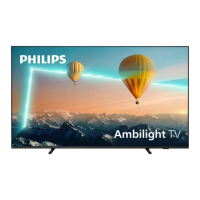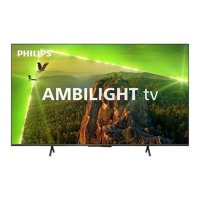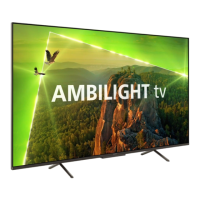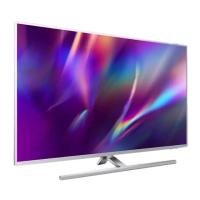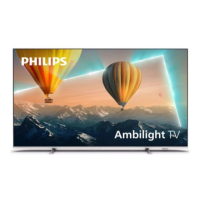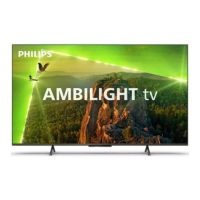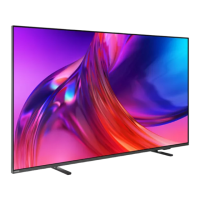
Do you have a question about the Philips 43PUS8818 and is the answer not in the manual?
| Screen shape | Flat |
|---|---|
| Response time | - ms |
| Display diagonal | 43 \ |
| Display brightness | - cd/m² |
| Display technology | LED |
| Native aspect ratio | 16:9 |
| Native refresh rate | 120 Hz |
| Supported video modes | 576p, 720p |
| Display diagonal (metric) | 108 cm |
| Supported graphics resolutions | 640 x 480 (VGA), 1920 x 1080 (HD 1080), 2560 x 1440, 3840 x 2160 |
| Display refresh rates supported | 24 Hz, 25 Hz, 30 Hz, 50 Hz, 60 Hz, 100 Hz, 120 Hz |
| Motion interpolation technology | - |
| Battery type | AAA |
| Batteries included | Yes |
| Ambient lighting type | 3-sided |
| Number of batteries supported | 2 |
| Stand type | Center stand |
| Stand color | Gray |
| Product color | Anthracite, Grey |
| Panel mounting interface | 100 x 200 mm |
| Cables included | AC |
| Package type | Box |
| Package depth | 150 mm |
| Package width | 1100 mm |
| Package height | 855 mm |
| Package weight | 13500 g |
| AC input voltage | 220 - 240 V |
| AC input frequency | 50/60 Hz |
| Energy efficiency scale | A to G |
| Power consumption (standby) | 0.3 W |
| Power consumption (typical) | - W |
| HDMI ports quantity | 4 |
| USB 2.0 ports quantity | USB 2.0 ports have a data transmission speed of 480 Mbps, and are backwards compatible with USB 1.1 ports. You can connect all kinds of peripheral devices to them. |
| Ethernet LAN (RJ-45) ports | 1 |
| Consumer Electronics Control (CEC) | EasyLink |
| Programming period | 8 day(s) |
| Music apps | YouTube Music |
| Video apps | Amazon Prime Video, Apple TV, BBC iPlayer, Disney+, Netflix, YouTube |
| App distribution platform | Google Play |
| Operating system installed | Google TV |
| Sound modes | AI Sound |
| Audio decoders | DTS, Dolby Atmos, Dolby Digital, DTS:X, Dolby MS12 |
| RMS rated power | 20 W |
| Game features | Auto Low Latency Mode (ALLM), Variable Refresh Rate (VRR) |
| AMD FreeSync type | FreeSync Premium |
| Teletext standards | Hyper-text |
| Audio formats supported | AAC, FLAC, MP3, WAV, WMA, WMA-PRO |
| Image formats supported | BMP, GIF, HEIF, JPEG, PNG |
| Video formats supported | AVC, AVI, H.264, HEVC/H.265, MKV, MPEG1, MPEG2, MPEG4, VP9 |
| Subtitle formats supported | ASS, SMI, SRT, SSA, SUB, TXT |
| Picture processing technology | Philips P5 Perfect Picture Engine |
| High Dynamic Range (HDR) technology | Dolby Vision, High Dynamic Range 10 (HDR10), High Dynamic Range 10+ (HDR10 Plus), Hybrid Log-Gamma (HLG) |
| Wi-Fi standards | Wi-Fi 5 (802.11ac) |
| Bluetooth version | 5.0 |
| Internal memory | 16000 MB |
| Tuner type | Analog & digital |
| Analog signal format system | PAL, SECAM |
| Digital signal format system | DVB-C, DVB-S, DVB-S2, DVB-T, DVB-T2, DVB-T2 HD |
| Stand depth | 259 mm |
|---|---|
| Stand width | 500 mm |
| Depth (with stand) | 212 mm |
| Height (with stand) | 628 mm |
| Weight (with stand) | 10800 g |
| Depth (without stand) | 77 mm |
| Width (without stand) | 963 mm |
| Height (without stand) | 567 mm |
| Weight (without stand) | 9100 g |
Importance of reading safety instructions before using the TV.
Instructions for attaching the TV stand or mounting the TV on a wall.
How to connect and handle the TV's power cable safely.
Detailed description of buttons on different remote control types.
Steps to pair the remote control with the TV via Bluetooth.
How to use voice commands for searching content on the TV.
How to turn the TV on, put it in standby, or reboot it.
Guide to installing satellite channels and configuring settings.
Guide to updating channels via antenna installation.
Procedure to reinstall all channels on the TV.
Locking channels and setting age ratings for content.
Features for deaf, hearing impaired, blind, or visually impaired users.
Creating and managing lists of favorite channels for easy access.
Information on HDMI connections, quality, and copy protection (HDCP).
Using HDMI ARC/eARC for audio return channel and advanced audio.
Settings for displaying Ultra HD signals and compatibility.
Connecting Home Theatre Systems via HDMI ARC/eARC.
Troubleshooting sound issues with Home Theatre Systems.
Using CI+ modules for conditional access and watching scrambled channels.
Connecting computers via HDMI to use the TV as a monitor.
Connecting the TV to a home network for internet access.
Steps for wireless and wired network connections.
Signing into a Google Account for full TV capabilities.
How to start and use the TV's built-in internet browser.
Adjusting picture settings for optimal viewing quality.
Adjusting contrast, HDR, and black levels for picture quality.
Personalizing audio based on hearing ability using Mimi technology.
Selecting surround sound effects and calibrating TV speakers.
Selecting audio output source and format.
Activating or deactivating Ambilight and selecting styles.
Overview of apps, Google Play Store, and app management.
Updating the TV's software via internet or USB.
Downloading and installing software updates from the internet.
Resetting TV settings to factory defaults or reinstalling channels.
Casting content from mobile devices to the TV using Google Cast.
Pairing and managing Bluetooth devices with the TV.
Using the Philips TV Remote App for mobile control.
Using the gaming control bar for game information and settings.
Overview of Amazon Alexa voice control features on the TV.
Setting up and using Alexa for TV control.
Running diagnostic tests for TV troubleshooting.
Solutions for common TV problems like no picture or sound.
Troubleshooting HDMI and USB connection issues.
Important safety instructions to prevent electric shock, fire, or injury.
Precautions to avoid electric shock or fire hazards.
Safety guidelines to prevent injury or damage to the TV.
Precautions to prevent the TV from tipping over.

